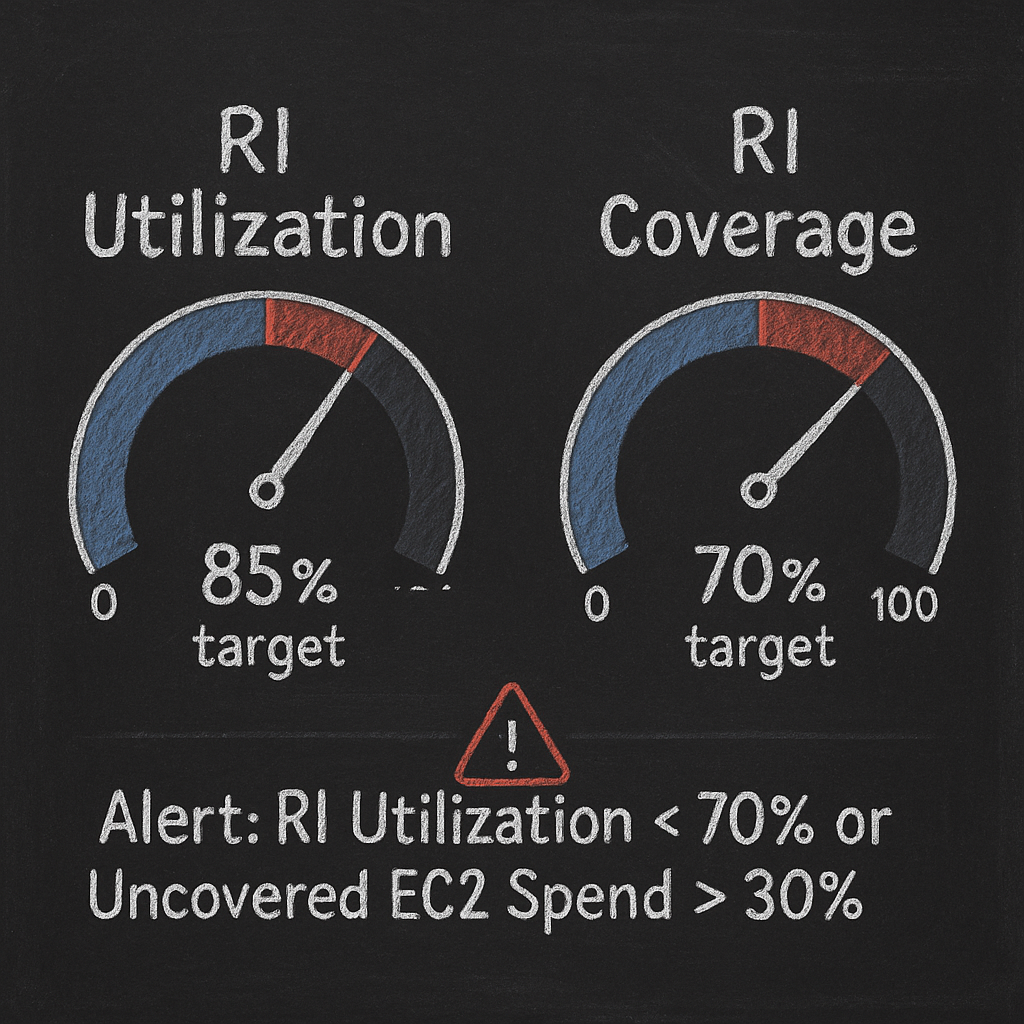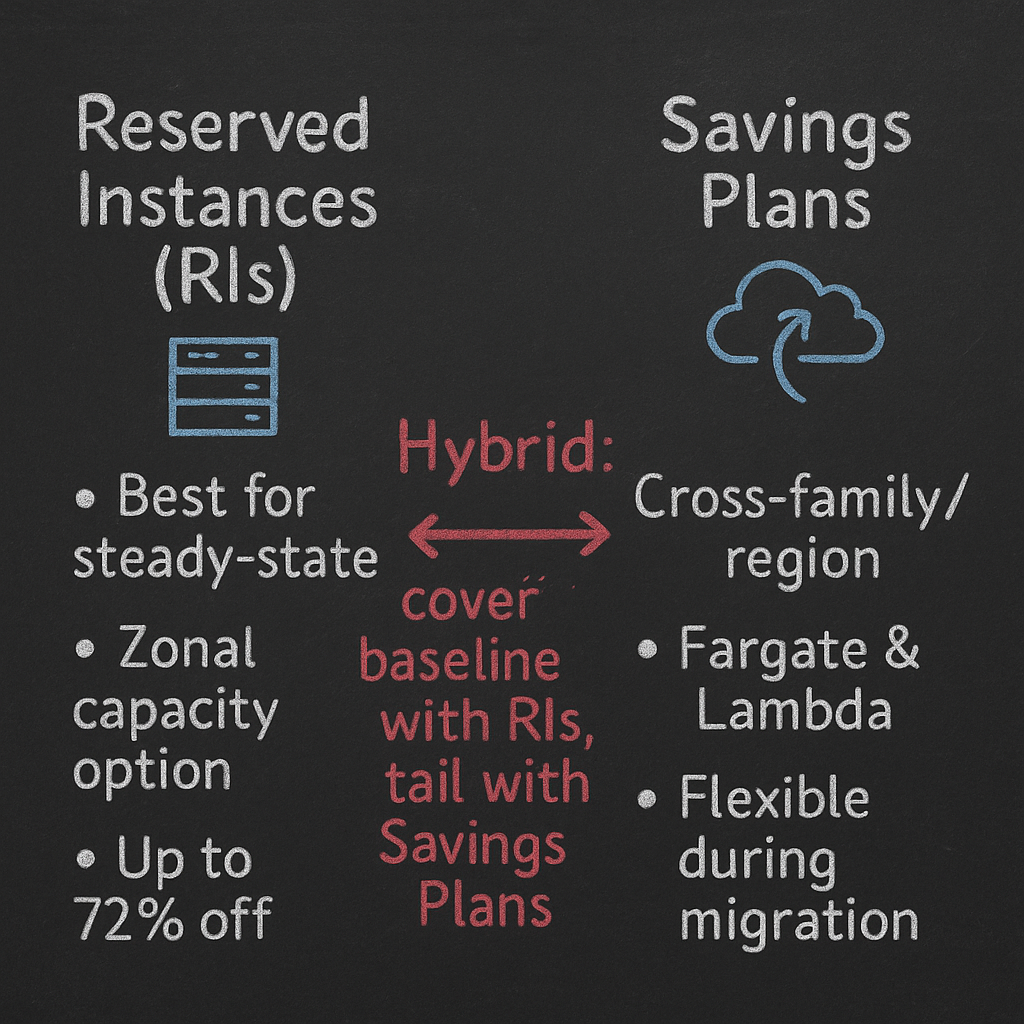AWS RI management for cost‑conscious teams: save 30–72% without overprovisioning
Steady EC2 spend but unpredictable usage? Done right, Reserved Instances can cut compute costs by up to 72%—done wrong, they lock you into waste.
This guide gives AWS cloud engineers and FinOps leads a practical playbook to purchase, manage, monitor, and allocate RIs with confidence, including when to prefer Savings Plans, how to match reservations to workloads, and the alerts and processes that prevent stranded spend.
What an AWS Reserved Instance really is (and isn’t)
An RI is a pricing discount and, optionally, a capacity reservation for EC2 when you commit to a 1- or 3‑year term. Key points you’ll use in practice:
Standard Reserved Instances provide the deepest discount and optional capacity reservation, but without conversions across families. They offer up to 72% off On‑Demand when paired with 3‑year All Upfront payment options. Convertible RIs provide a lower discount but allow changes to instance family, size, OS, or tenancy during the term, offering up to 66% off On‑Demand. For specific needs, Scheduled RIs reserve capacity for time‑windows like 12 hours per day.
When considering scope, Regional RIs apply discounts across Availability Zones in a region without capacity guarantees, while Zonal RIs tie to a specific AZ and include capacity reservation—useful for stateful apps needing AZ affinity.
Instance size flexibility allows Regional Standard and Convertible RIs to apply across sizes of the same family. For example, an m6i.2xlarge RI can discount two m6i.xlarge hours. This flexibility isn’t available for zonal RIs.
For terms and payments, you can choose between 1‑year or 3‑year terms, with All Upfront providing the highest savings, followed by Partial Upfront and No Upfront. Standard RIs offer the highest discount with 3‑year All Upfront, while Convertible RIs typically trade 10–15% less discount for flexibility.
For context, a London m5.large 3‑year All Upfront Standard RI often lands around 60–72% off On‑Demand; 1‑year No Upfront Standard RI around 42.7% off, with Convertible typically offering about 10–15% less discount for the same term.
How RIs apply on your bill
Reserved Instance discounts follow a specific allocation order under consolidated billing. They apply at the payer account level first, then linked accounts, and target the most expensive eligible usage first.
You’ll need to track two critical metrics:
RI utilization = RI hours used / RI hours purchased RI coverage = RI‑discounted usage / total eligible usage
Industry benchmarks suggest targets of utilization ≥85% and coverage ≥70% for production workloads. When utilization falls below 70%, it typically signals overprovisioning.

To stay on top of these metrics, set critical alerts such as “RI Utilization < 70%” and “Uncovered EC2 Spend > 30%” on hourly or daily cadence for production environments.
When to use RIs vs. Savings Plans
Reserved Instances work best when your workload is steady-state, predictable, and sticks to one instance family, OS, and tenancy. They’re also ideal when you need zonal capacity reservation or want the option to resell unused Standard RIs in the Marketplace.

Savings Plans are preferable when you need flexibility across EC2 families and regions, or want coverage for Fargate and Lambda. They’re also better when workloads change instance types frequently or you’re mid-migration (e.g., x86 to Graviton).
AWS often recommends Savings Plans for flexibility with similar headline discounts (up to 72%) compared to RIs. Third-party analyses show Savings Plans often outperform RIs by 5-10% for variable fleets due to automatic cross-family coverage.
A hybrid strategy that works well for many organizations is covering the 60-80% baseline with Standard/Convertible RIs and the variable tail with Compute Savings Plans. A UK e-commerce platform cut costs by 52% versus On-Demand using roughly 70% RIs and 30% Savings Plans.
Workload-matching strategies (with real examples)
For always-on web/app tiers that autoscale across AZs, Regional Standard RIs work best for the steady baseline. Instance size flexibility smooths right-sizing and small family-consistent shifts. In one example, 10 m5.large instances running 24/7 in eu-west-2 saw costs drop from £4,200/month to £2,480/month using 1-year No Upfront Standard RIs—a 41% reduction.
Stateful services with AZ affinity, such as databases and legacy apps, benefit from Zonal Standard RIs to guarantee capacity in a specific AZ. Be careful not to overcommit—measure steady 95th percentile usage before purchasing.
For evolving services or systems in migration (such as x86 to Graviton, or Windows to Linux), Convertible RIs allow family/OS changes mid-term. Gartner notes the approximately 15% discount delta versus Standard RIs is justified when workload volatility exceeds 25%.
Avoid RIs for low-duty-cycle fleets like dev/test, batch, and ephemeral workloads. Instead, use On-Demand with schedules or Spot instances. For batch processing, choose Spot or Savings Plans unless jobs run near 24/7.
With Kubernetes clusters, map node groups to instance families and buy RIs to cover the steady worker baseline, keeping burst capacity on On-Demand/Spot. Tie in EBS optimization for nodes to prevent overpaying for storage IOPS; see our guide on optimized EBS volume sizing and performance tuning aws.
Before committing to RIs, prove ≥80% steady utilization for at least 3 months. Then buy to cover 70-90% of observed baseline and rely on size flexibility to absorb 70-130% of RI capacity.
Purchasing decisions that move the needle
When choosing term length, 3-year commitments maximize discount but raise lock-in risk, while 1-year terms are safer during migrations.
For payment options, All Upfront provides the greatest discount, followed by Partial Upfront and No Upfront. Choose based on cash constraints and expected fleet changes.
Regarding offering class, Standard RIs work best for steady fleets, while Convertible RIs are better for evolving fleets.
For scope, choose Regional RIs for autoscaling and flexibility, and Zonal RIs when you truly need capacity reservation.
If you plan to trade on the secondary market, buy common configurations and shorter terms to improve liquidity. Our primer on the reserved instances marketplace explains how algorithmic buyers shape pricing and why 1-year inventory moves faster.
Note important policy changes: As of January 2024, Enterprise Discount Program (EDP) customers cannot sell discounted RIs on the Marketplace. Effective June 1, 2025, RIs and Savings Plans are restricted to a single end customer, prohibiting MSP/reseller “hub and spoke” benefit distribution.
Monitoring, allocation, and showback that prevent waste
Effective tagging and Cost and Usage Report (CUR) discipline are essential. Require cost allocation tags at resource creation and enforce them on RI purchases. Common tags include environment, owner, and application. Stranded RIs from untagged resources account for 15-25% waste, with 68% of allocation errors tracing back to poor tagging.
For monitoring, AWS Cost Explorer RI reports track utilization and coverage, while Budgets handle thresholds and Trusted Advisor offers purchase recommendations. CUR provides detailed showback. Review weekly and set alerts for utilization below 80%.
Third-party tools like CloudHealth and Cloudability add advanced matching capabilities, while Kubecost provides Kubernetes showback. Note that many tools still require manual intervention to execute “buy/modify” actions.
Remember that RI discounts apply at the payer account level first, then linked accounts, targeting the priciest eligible usage first. This allocation behavior matters for showback—validate chargeback logic against the allocation order.
For broader governance, see our checklist on aws cost management best practices.
Common pitfalls and how to avoid them
Overprovisioning the wrong fleets is a common mistake. Buying RIs for dev/test environments with 40% duty cycles leads to stranded hours. In one case, 5 zonal RIs for dev/test wasted approximately £1,150/month in eu-west-2; rightsizing saved 35%.
Ignoring migrations can also be costly. Committing to x86 during a Graviton migration erodes savings. Prefer 1-year or Convertible RIs during migration windows and align with your Graviton roadmap and benchmarking.
Zonal RIs lock you to one AZ and disable size flexibility. Only choose zonal RIs for true capacity constraints.
Without enforced tags and regular alerts, waste can persist for months. Automate RI drift detection and run monthly portfolio reviews.
Remember that RIs don’t apply to Fargate/Lambda; Savings Plans do.
Numbers to anchor your targets
Standard RI discount potential reaches up to 72% versus On-Demand with 3-year All Upfront. Convertible RIs offer up to 66% off with flexibility, typically 10-15% less than Standard for the same term.
Industry benchmarks suggest utilization ≥85% and coverage ≥70% for production workloads.
Critical alerts to implement include “RI Utilization < 70%” in Cost Explorer and “Uncovered EC2 Spend > 30%” in Budgets.
For Marketplace transactions, only Standard RIs can be resold, with approximately 12% fee. Average resale takes about 45 days and typically yields 15-20% below the original price, with policy exceptions applying to EDP discounts.
A practical 30-day RI action plan
Days 1-7: Baseline your environment by pulling 90-day usage by family/size/region from CUR/Cost Explorer. Identify steady 24/7 baseline by service/ASG and tag completeness. Quantify current coverage/utilization and set alerts.
Days 8-15: Right-size and stabilize by addressing overprovisioned instances and aligning EBS gp2→gp3 where appropriate to prevent buying RIs on oversized volumes. Normalize AMIs/tenancy to simplify RI scope.
Days 16-21: Purchase incrementally, committing 50-70% of proven baseline with 1-year Standard Regional RIs. Use Convertible RIs for fleets likely to change and consider a small Compute Savings Plan to handle variable usage.
Days 22-30: Automate and iterate by scheduling weekly RI utilization/coverage reports and monthly portfolio reviews. Set marketplace exit criteria for any stranded Standard RIs and document showback with enforced tags, validating allocation behavior.
Prefer to run this on autopilot? Hykell’s automation continuously matches purchases to real usage, balances RI vs. Savings Plans, times marketplace listings, and enforces alerts—so you capture savings without engineering toil. Explore automated reserved instance management to see how teams save 30-40% with hands-off execution.
FAQs quick answers
What is an RI in AWS, and how does it work?
A 1- or 3-year pricing commitment that discounts eligible EC2 usage; Standard RIs can also reserve capacity in a specific AZ. Discounts apply automatically to matching usage by family/scope/payment.
What is RI utilization in AWS?
The percentage of purchased RI hours actually used (used hours ÷ purchased hours). Coverage measures the share of total eligible usage discounted by RIs.
Which purchase option is most cost-effective?
3-year All Upfront Standard RIs maximize savings but increase lock-in. Balance term/payment against fleet volatility and cash constraints.
What are the three RI types?
Standard, Convertible, and Scheduled.
What’s best for batch processing?
Usually Spot or Savings Plans for flexible batch; RIs only if batch is near 24/7 steady and family-stable.
What are RI disadvantages?
Lock-in risk, potential for stranded spend, family/region specificity (for Standard), and resale constraints (especially after 2024-2025 policy changes).
How much can you save with RIs?
Up to 72% for Standard and up to 66% for Convertible versus On-Demand.
Which is better: RIs or Savings Plans?
For steady, family-stable fleets or zonal capacity needs, RIs win. For evolving fleets or when using Fargate/Lambda, Savings Plans typically win. Many teams adopt a hybrid approach.
Tie RIs into your broader cost strategy
Layer RIs with Savings Plans, rightsizing, Spot, and EBS tuning to avoid paying for capacity you don’t need.
If you negotiate enterprise commitments, align RI/Savings Plans with your amazon aws edp to avoid double-committing.
Comparing clouds? See how discounts differ in our 2025 view: compare aws gcp prices.
Hykell helps you capture RI savings automatically—no spreadsheets, no guesswork, no risk of overbuying. If we don’t save you money, you don’t pay. See what you could save on hykell and get started with aws reserved instances optimization.
